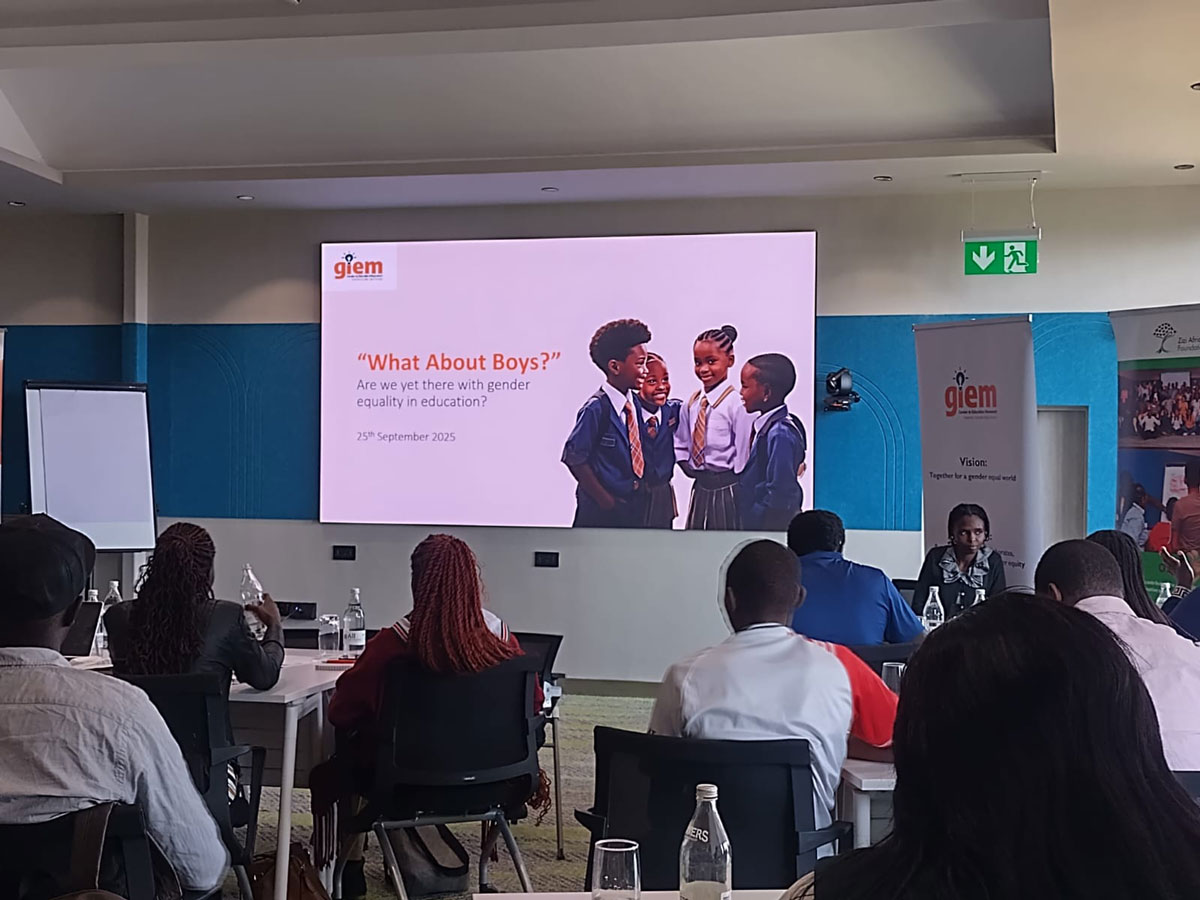Here is the paradox of modern gender roles: as a society, we want change, but not too much. It is difficult to shed outdated expectations because society often rewards those who conform and penalizes those who deviate. While globalization pushes shifts in traditional roles, we have yet to have a meaningful national conversation about what this means for future generations. History shows that maintaining the status quo may feel easier, but it often reinforces stereotypes and perpetuates inequality.
Kenya’s progress on gender equality is held back by a web of narratives woven from rigid gender roles, cultural traditions, and religious norms. One such narrative is the framing of gender equality as a competition. Gains for girls are misinterpreted as losses for boys. Advocacy for the boy child is cast as a backlash against the “over-empowerment” of girls where an “over-empowered” girl is simply one who dares to excel, lead, or make choices for herself. In the least, this framing gives way to unnecessary friction against gender equality efforts. At its worst, it becomes fertile ground for justifying excessive measures to win the competition, such as discrimination, gender-based violence and femicide. As a society, we must become deliberate about the narratives we pass to the next generation on gender equality, especially on the role male engagement plays.

Male Engagement: The Evolving Narrative in Gender and Education
Often, the mention of male engagement evokes a picture of men rallying behind women’s efforts to attain gender equality. The Ministry of Gender, Culture and Children Services defines male engagement as a gender transformative approach where male allies partner in transforming social norms, ending gender-based violence and addressing inequalities. Across board, there is agreement that male engagement remains critical, but this is against the backdrop of a disgruntled acknowledgement that men remain gate keepers of a patriarchal society.
The What About Boys Summit hosted on 25 September 2025 by the Gender in Education Movement under the theme What Works in Promoting Boys and Men Engagement toward Gender Equality, gave stakeholders an opportunity to dig deeper into this evolving conversation. The consensus was clear: gender equality is not a zero-sum game. Male engagement must be resourced to serve a dual purpose both dismantling barriers that hold girls back and responding to the distinct challenges boys face.
‘’Our commitment to the ‘What About Boys?’ agenda is unwavering because empowering boys is not a detour from equality, it is a direct path to a more just, inclusive, and compassionate Kenya for all.” Mr. Nzomo Mbithuka – Commissioner, National Gender and Equality Commission -(NGEC) said during his opening remarks, underscoring the spirit of the conversation that ran through the day.

Gender Equality in Education Barriers to Education: Same Education Pipeline, Different Leakage Points
Despite progress in access and transition rates, girls remain disproportionately affected by deeply entrenched barriers: period poverty, teenage pregnancy, and early marriage remain the biggest contributors to girls’ absenteeism and dropout. According to the Kenya National Examination Council (2022), pregnancy was the leading cause of girls dropping out of Form 2 (54.5%), followed by early marriage (26.6%). Outdated traditions such as Female Genital Mutilation (FGM) continues in parts of Kenya, undermining health, dignity, and educational continuity. While girls enroll in primary school at near parity with boys, fewer transition into and complete secondary and post-secondary education, widening disadvantage later in life.
At the same time, boys are facing challenges often overlooked in gender discourse. According to the Male Engagement and Inclusion Strategy (2025 – 2030), The State Department for Gender Affairs and Affirmative Action identified increasing dropout rates for boys, where high numbers at enrollment at Primary, Secondary and Tertiary institutions are not translating to high completion rates. The strategy outlines that among the cohort that joined grade 1 in 2013, only 79.7% of boys completed primary education (Ministry of Education, 2023). Reasons for dropping out of secondary school include socio economic and cultural practices, with key barriers to education including substance abuse, labor, economic burdens, family duties, and a decrease in male role models in schools due to decline of male enrolment in teacher training institutions.
National Kenya Certificate of Primary Education (KCPE) records (2019–2023) show that although registrations of boys and girls are almost proportionate, more boys than girls consistently fail to sit the exam despite being registered. For example, in 2023, 726,513 boys were registered but only 721,544 sat, compared to 689,798 girls registered and 685,017 sitting. This points to unique challenges in exam preparedness and persistence among boys. The disparities are even sharper in pastoralist counties. In 2023, Mandera registered 6,512 boys against 4,172 girls, yet large numbers of boys failed to sit the exam. Wajir (6,468 boys vs. 5,232 girls) and Garissa (7,045 boys vs. 5,479 girls) reflect similar patterns, showing that boys start ahead in enrolment but are disproportionately lost before transition. At the same time, 32% of girls and 20% of boys in Arid and Semi-Arid Lands (ASALs) have never attended school at all (FLANA 2023), proving that both genders are affected by context-specific vulnerabilities
Children are facing numerous socio-economic, cultural and systemic barriers to education. These issues cause “leaks” in the education pipeline— at different pressure points, that affect both boys and girls in unique ways. The question remains, how do we as a country trudge through the wins and challenges of an evolving gender context, while keeping our eyes on the prize, that is, to give all children equal access to quality education?
It is important to underscore the critical role that data plays in efforts to address gendered barriers to education. Nationally representative, and up-to-date data on gender and education remains scarce, making it difficult to track progress or respond effectively to emerging challenges. Without timely evidence, policies risk being reactive rather than transformative, leaving critical gaps in addressing the needs of both girls and boys.
Despite these emerging insights, there is still a lack of robust, disaggregated data on barriers facing boys. This makes it challenging to design interventions that are truly gender equitable. Without stronger evidence, national education strategies risk overlooking boys’ dropout crisis while still not adequately addressing the systemic disadvantages faced by girls.
The reality is that both girls and boys are navigating an uneven playing field—but at different points along the education pipeline. Effective solutions must recognize these distinctions, closing the gaps for girls while not leaving boys behind.

Taking Action to Shape the Narrative
Strategic actions proposed at the What About Boys Summit included:
- Deepen the dual role of male engagement – Male engagement continues to play a critical role in addressing gendered barriers to education for girls. Men should also take lead to champion the creation of safe spaces for boys to discuss issues hampering their education and receive support and mentorship.
- Open up platforms for inter-generational dialogue to redefine masculinity – Times are changing fast. Old and outdated gender roles must be redefined, and we must be keen not to do so using harmful, “Us versus Them” One of the youth in attendance of the summit put it well – gender equality is not a favor to women or a loss to men- but the key to a better Kenya.
- Sustainable action must be catalyzed at household level: For sustainability, there is need for ownership at the household and community levels. We must not underestimate the role that parental engagement and communities providing mentorship in neighborhoods and schools plays in the shaping of narratives around gender equality in education.
- Speaking with one voice – Join the Gender in Education Movement: Collaboration across different actors at all levels – government, schools, civil society and communities – is needed to create both national research and documented lived experiences of girls’, boys’ and intersex barriers to education. Combined, this evidence will be instrumental in shaping the evolving narrative on gender and education.

